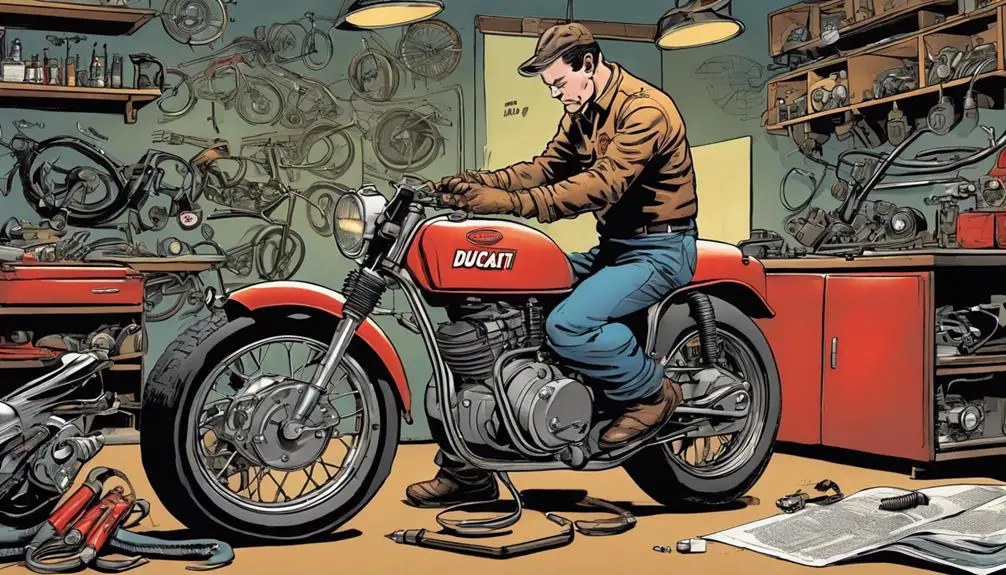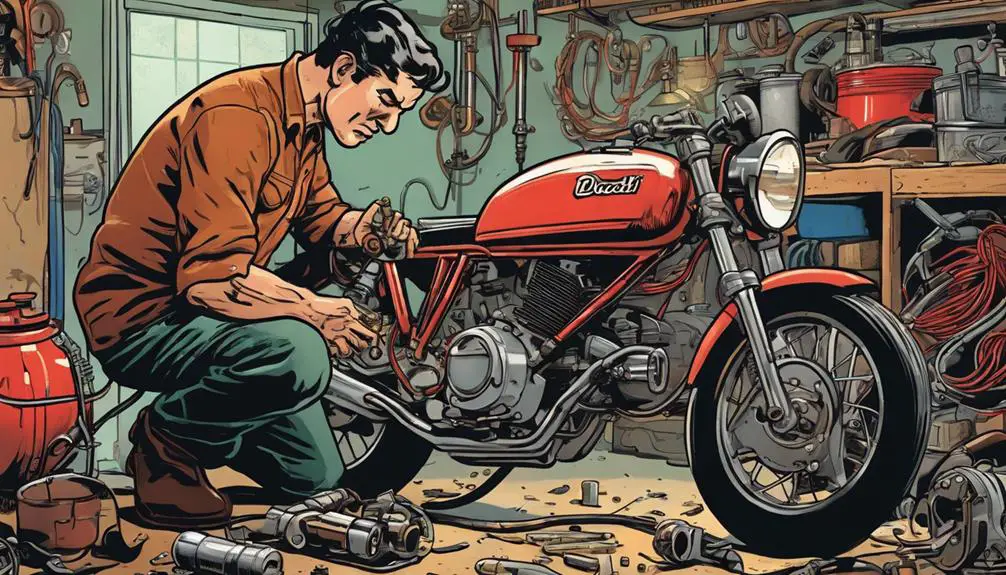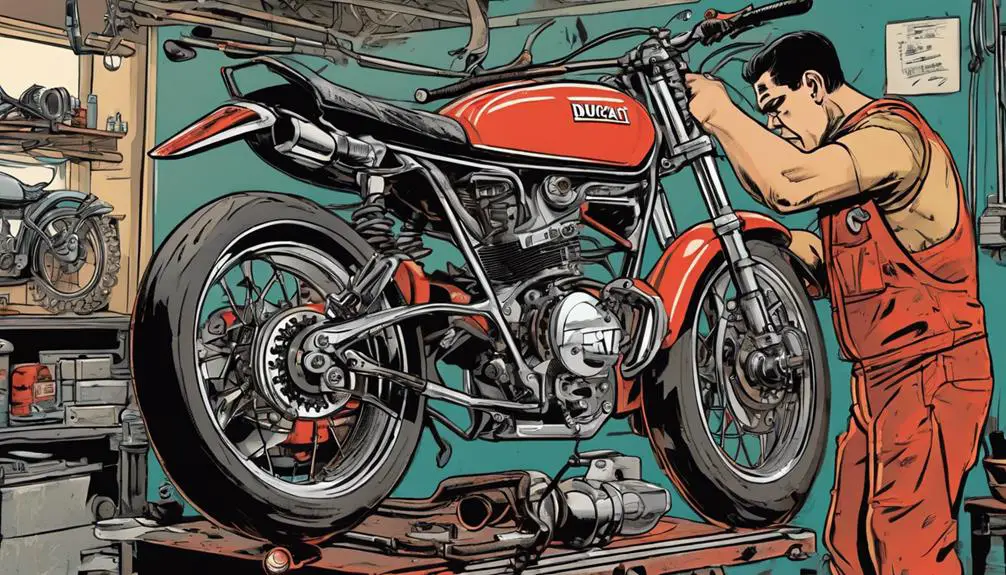Picture yourself on a vintage Ducati, the engine rumbling beneath you, but something feels off. You might notice it's not performing as it should, and that's when you realize it's time to troubleshoot. By checking the fuel system for clogs or inspecting the electrical components, you can often pinpoint the issue. However, as you dig deeper into the quirks of your Ducati, you'll find that each problem can lead to unexpected revelations about its performance. What could these issues reveal about your beloved bike's history?
Key Takeaways
- Check the fuel system for old fuel, clogs, or dirty carburetors that can impact engine performance.
- Inspect the electrical system, including the battery and wiring, to identify any faults or shorts.
- Examine spark plugs and air filters; replace worn plugs and clean filters to ensure proper combustion.
- Review transmission components like the clutch cable and oil levels to address shifting issues.
Engine Performance Issues

When you notice a decline in your vintage Ducati's engine performance, it often signals an underlying issue that needs addressing. You might feel a loss of power or hear unusual noises, both of which can dampen your riding spirit.
Start by checking the fuel system; old fuel can lead to clogs and poor combustion. Replace any stale fuel and clean the carburetors.
Next, inspect the air filter. A dirty filter restricts airflow, making your engine struggle. Clean or replace it to guarantee it breathes freely.
Don't overlook the spark plugs, either. Worn or fouled plugs can cause misfires, so check their condition and replace them if necessary.
You should also examine the chain and sprockets. A worn chain can sap your bike's energy, making it feel sluggish. Lubricate and adjust them regularly to keep your ride smooth and responsive.
Electrical System Failures
Electrical system failures can leave your vintage Ducati stranded, so it's essential to troubleshoot any signs of malfunction promptly.
Start by checking the battery; a weak or dead battery is often the culprit. Make sure the terminals are clean and tight, as corrosion can hinder the flow of power. If the battery seems fine, inspect the wiring harness for frayed or damaged wires. A short circuit could disrupt your ride, so look for any signs of wear.
Next, examine fuses for any that might've blown. Replace them with the correct amperage to avoid further issues.
If your lights are flickering or not working, the issue may lie in the switch or bulbs. Test them individually to rule out other problems.
Fuel System Problems

Fuel system problems can greatly impact your vintage Ducati's performance, so addressing them quickly is essential. When you notice a dip in power or hear strange sounds, it's time to investigate.
Here are three common fuel system issues you might face:
- Clogged Fuel Lines: Dirt and debris can accumulate, restricting fuel flow. Check for blockages and clean or replace the lines as needed.
- Dirty Carburetors: Old fuel can leave varnish that clogs jets and passages. Remove the carburetors, clean them thoroughly, and consider rebuilding them if necessary.
- Faulty Fuel Pump: If your bike struggles to start or runs inconsistently, your fuel pump might be failing. Test it with a pressure gauge and replace it if it's not delivering the right pressure.
Transmission Troubles
Dealing with transmission troubles in your vintage Ducati can be frustrating, but identifying the symptoms early can save you time and costly repairs.
If you're experiencing difficulty shifting gears or if the bike jumps out of gear, it's essential to act quickly. Start by checking the clutch cable for any loosening or fraying; a properly adjusted cable guarantees smooth gear engagement.
Next, listen for unusual noises, like grinding or clunking sounds when changing gears. This could indicate worn gears or a failing shift fork. Inspect the oil; dirty or low oil can lead to poor lubrication, exacerbating transmission issues.
Don't overlook the possibility of a bent shift lever; it can misalign your shifting mechanism. If you feel resistance when shifting, it might be time to replace the clutch plates.
Lastly, if you've gone through these checks and still face issues, consider consulting a professional. Embracing the challenge of maintaining your vintage Ducati not only liberates your ride but also deepens your connection to this classic machine.
Suspension and Handling Concerns

After addressing transmission troubles, you might notice that your vintage Ducati's suspension and handling can also impact your riding experience considerably. A well-tuned suspension allows you to embrace the open road with confidence, while poor handling can hold you back from that sweet liberation you crave.
Here's what to check:
- Fork Seals: Inspect for leaks. Worn or damaged seals can lead to a soggy front end, compromising control.
- Rear Shocks: Verify they're functioning properly. If they're worn out, you might experience bumpy rides and decreased stability.
- Tire Pressure: Keep an eye on this. Underinflated tires can cause sluggish handling and affect your overall performance.
Once you've gone through these points, take your Ducati for a spin. Feel how the changes elevate your ride. If issues persist, consider consulting a specialist who understands the nuances of vintage machines.
Frequently Asked Questions
How Do I Identify Original Parts on My Vintage Ducati?
To identify original parts on your vintage Ducati, start by researching the specific model and year.
Check the part numbers, which are usually stamped or labeled, against official Ducati documentation.
Look for signs of wear and patina that match the bike's age.
Don't forget to consult online forums or clubs where fellow enthusiasts share insights.
Embrace the thrill of discovery, and you'll find the authenticity that makes your ride truly special.
What Are the Best Maintenance Practices for Vintage Ducati Bikes?
Maintaining a vintage Ducati is like nurturing a cherished relationship; it requires care and attention.
You should regularly check and change the oil, inspect the brakes and tires, and clean the air filter.
Don't forget to keep the chain lubricated and adjust the tension.
Riding it often helps keep the engine healthy.
How Can I Determine My Ducati's Production Year?
To determine your Ducati's production year, start by locating the Vehicle Identification Number (VIN) on the frame or engine.
Once you've found it, decode the VIN; the first digits usually reveal the model year.
You can cross-reference this info with Ducati's official production records or enthusiast forums.
Don't hesitate to reach out to fellow Ducati owners for insights, as they often have valuable knowledge about specific models and their production timelines.
Where Can I Find a Reliable Vintage Ducati Mechanic?
Finding a reliable vintage Ducati mechanic is like searching for a rare gem in a vast landscape. You want someone who understands the soul of your bike, not just its mechanics.
Start by tapping into local motorcycle communities, forums, or social media groups where passionate riders gather. They'll often share recommendations.
Don't hesitate to visit shops; feel the vibe and ask questions. Trust your instincts, and you'll uncover a true Ducati whisperer.
What Are Common Restoration Tips for Vintage Ducati Enthusiasts?
When restoring your vintage Ducati, focus on sourcing authentic parts to maintain its integrity.
Don't rush the process; take your time to inspect every component.
Clean and polish the metal surfaces, and consider using high-quality paint for a fresh look.
Keep an eye on the wiring; it often needs attention.
Conclusion
In summary, troubleshooting your vintage Ducati can be a rewarding journey.
By checking engine performance, inspecting the electrical system, cleaning the fuel system, addressing transmission troubles, and fine-tuning the suspension, you'll not only enhance your bike's functionality but also deepen your connection with it.
So, immerse yourself, take your time, and enjoy the process—your Ducati deserves it, and you'll love the ride even more when it's running smoothly!